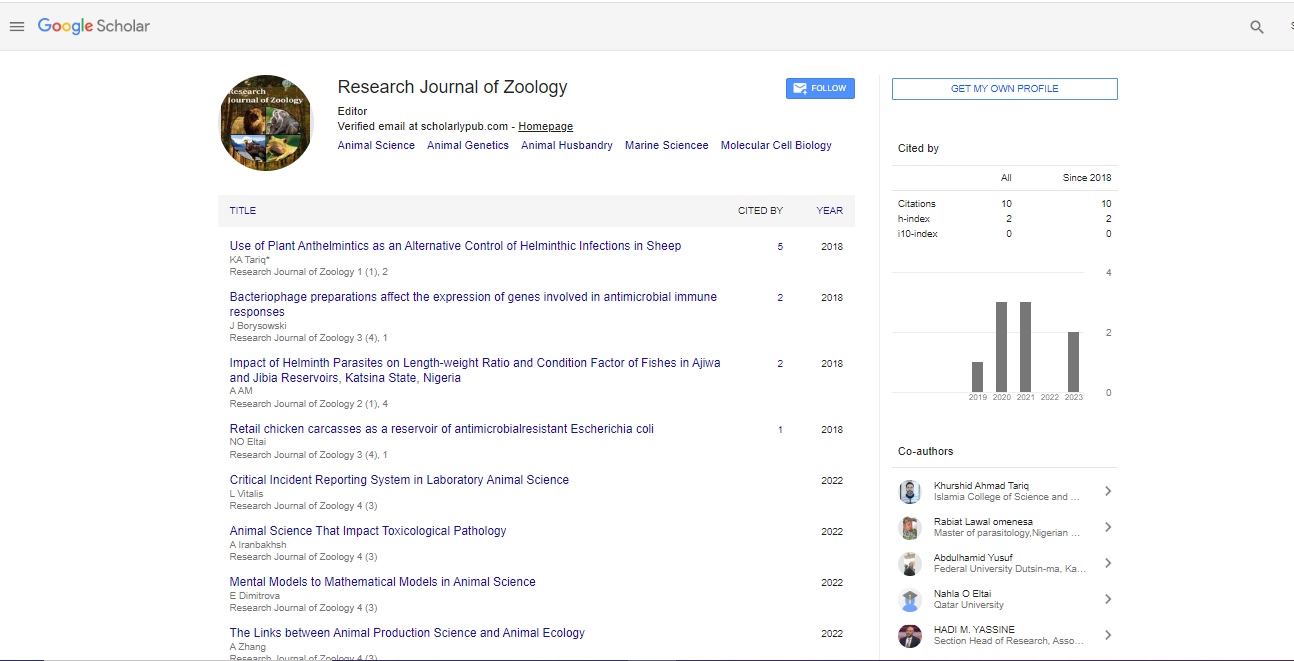Perspective, Res J Zool Vol: 4 Issue: 2
Ebola Virus Development Research and Progress
Tommaso Monaco*
Department of Genetics, University of Pretoria, Pretoria, South Africa
Corresponding Author: Tommaso Monaco
Department of Genetics, University of Pretoria, Pretoria, South Africa
E-mail:amonaco@gmail.com
Received date: 01 March, 2022, Manuscript No. RJZ-22-62894;
Editor assigned date: 03 March, 2022, PreQC No. RJZ-22-62894 (PQ);
Reviewed date: 17 March, 2022, QC No RJZ-22-62894;
Revised date: 21 March, 2022, Manuscript No. RJZ-22-62894 (R);
Published date: 31 March, 2022, DOI: 10.4172/ RJZ.100064
Citation: Monaco T (2021) Ebola Virus Development Research and Progress. Res J Zool 4:2.
Keywords: Zoography, Comparative Anatomy, Animal Physiology, Behavioral Ecology, Ethology or Animal Behavior
Description
The Ebola infection was distinguished in the year 1976 and has caused intermittent episodes in West African nations. The infection has a case casualty rate up to 90%. Ebola has been named a biosafety level four microbe and there is no presently endorsed immunization or treatment for the infection. Be that as it may, striking advancement has been shown by analysts in understanding the pathogenicity of the Ebola infection. A few creature models have been developed to create diagnostics, immunizations and remedial medications. The Ebola infection was distinguished in the year 1976 and has caused intermittent episodes in West African nations. The infection has a case casualty rate up to 90%. Ebola has been named a biosafety level four microbe and there is no presently affirmed immunization or treatment for the infection. Notwithstanding, astounding advancement has been exhibited by scientists in understanding the pathogenicity of the Ebola infection. A few creature models have been developed to create diagnostics, immunizations and restorative medications. The sickness is described with side effects and indications of fever, central rot of the liver, kidney and spleen draining diathesis, fulminant stun bringing about death with a death rate arriving at 90%. The initial two episode of the EBOV included sicknesses, for example, fever, migraine, regurgitating and looseness of the bowels.
Hemorrhagic Signs
The principal episode of an obscure irresistible infection (Marburg sickness) was accounted for in Germany and Yugoslavia in the year 1967. An expected 37 people were influenced in which 5 people kicked the bucket. Ultimately, another strand of the infection was removed from a patient and was followed back to velvet monkey imported from Uganda. The illness was named the 'Marburg infection' since it was situated in the West German town of Marburg. The infection is exceptionally infectious which is sent to people in direct contact with natural liquids from a contaminated individual. The danger of transmission is most elevated during the inert phase of the sickness however the degree of transmission diminishes during the beginning phases regardless of whether there is high danger openness. People that are at the most serious danger for contamination of the EBOV during an episode are, researchers, medical services laborers, family members and those in close contact with sick people and expired patients. In the 2014 flare-up, the World Health Organization directed a virological examination to decide whether there was any linkage between the EBOV in West Africa and the Democratic Republic of Congo. The epidemiological examination and results reasoned that the episodes in the Democratic Republic of Congo were totally isolated and free occasion from the cases revealed in West Africa. Nonetheless, agents have detached 99 EBOV genomes from tainted patients in Sierra Leone.
Ebola infection
Endless supply of the examples, examiners presumed that there is quick change of the infection which could have suggestion for the improvement of diagnostics, antibodies, and treatments of the EBOV. The infection causes an exceptionally deadly hemorrhagic fever and the most hazardous specie is the Zaire Ebola, with a death pace of 95%. The most conspicuous supply for the Ebola infection is the natural product bat. At the point when the infection was first recognized in 1967 and throughout the long term the quantity of strains expanded to five species. The indications of the infection can be confused with different illnesses that are comparable in nature. By far most of people in danger for the Ebola infection have been occupants of rustic Central Africa. A portion of the reasons related with episodes of the Ebola infection are impediment in wellbeing observation and lacking precaution measures. As of late, analysts have proposed that nearby contact with contaminated individual, and the most recent potentially that the infection is airborne adds to the high infectivity of the Ebola infection. The Ebola infection is altogether influencing a dominant part of people in West Africa and much advancement has been made in the comprehension of the infection replication. Advances have been made in the improvement of medications/immunizations for the infection yet there is a requirement for more exploration in the improvement of an antibody or medication that is viable to handle all the different types of the Ebola infection.
 Spanish
Spanish  Chinese
Chinese  Russian
Russian  German
German  French
French  Japanese
Japanese  Portuguese
Portuguese  Hindi
Hindi 
